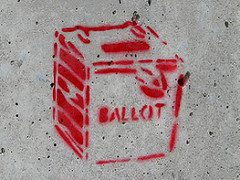
The following is a scan of housing-related ballot measures in The Golden State. With such a steeped interest in housing at a local level, and an expected high turnout this November, many advocates are watching with considerable interest how voters react. The outcome will shape the nature of discussion on housing policy for years to come.
1. Revenue and Funding Measures for Housing Production and Homeless Services
Jurisdiction: Alameda County
Measure A1: $580 million in general obligation bonds for housing.
Jurisdiction: Berkeley
Measure U1: Increases business license tax on landlords of market-rate apartments, intends to raise $4 million annually for affordable housing and homeless.
Jurisdiction: East Palo Alto
Measure O: Imposes 1.5 percent tax on gross residential rental receipts, generating $600,000 annually to fund affordable housing, tenant displacement, foreclosure prevention, and homelessness.
Jurisdiction: Healdsburg
Measure S: Levies a 2 percent hotel room tax, raising $530,000 annually dedicated to affordable housing services and programs.
Jurisdiction: Los Angeles
Measure HHH: $1.2 billion general obligation bond for 10,000 housing units for the homeless
Jurisdiction: San Francisco
Proposition J: Charter amendment to create a Homeless Housing and Services Fund. Beginning in 2018 and for the next 24 years, the city would allocate $50 million to the fund each year, adjusted based on changes in city revenues. Also creates a transportation fund.
Jurisdiction: San Francisco
Proposition C: Allows the city to spend the unused $261 million from a 1992 general obligation bond for seismic safety upgrades and convert those buildings to permanent affordable housing.
Jurisdiction: San Francisco
Proposition S: Allocates a share of the existing hotel room tax for family homeless services.
Jurisdiction: Santa Monica
Measure GS: Advisory measure allows half of revenue raised from a companion ½ cent sales tax to be spent on affordable housing and homeless services.
Jurisdiction: Santa Clara County
Measure A: $950 million general obligation bond to fund homeless services and affordable housing.
Jurisdiction: South Lake Tahoe
Measure Q: An advisory measure that allows the city to spend the sales tax increase from a companion measure on housing.
2. Anti-gentrification, Rent Control and Anti-Displacement Measures
Jurisdiction: Alameda
Measure L1: Rent Stabilization Ordinance limiting rent increases to once a year, requiring mediation for all increases above 5 percent, limiting grounds for evictions, and requiring landlords to pay relocation fees when terminating certain tenancies.
Jurisdiction: Alameda
Measure M1: Charter amendment with rents “rolled back” to May 5, 2015 levels. The annual allowable rent increase is limited to 65 percent of the Consumer Price Index.
Jurisdiction: Berkeley
Measure AA: Increases protection for renters and relocation assistance under Rent Stabilization Ordinance.
Jurisdiction: Burlington
Measure R: Establishes rent stabilization and just cause for evictions. Rent increases are tied to inflation, but limited to 1 to 4 percent annually.
Jurisdiction: East Palo Alto
Measure J: Strengthens and clarifies the existing Rent Stabilization and Just Cause for Eviction Ordinance.
Jurisdiction: Humboldt County
Measure V: Preserves mobile home parks in unincorporated areas of Humboldt County by regulating fee spikes when a home is sold and limiting monthly lot rents to annual increases at the consumer price index.
Jurisdiction: Mountain View
Measure V: Charter amendment establishes rent stabilization with increases between 2 to 5 percent tied to inflation. A competing Measure W establishes an ordinance with dispute resolution.
Jurisdiction: Oakland
Measure JJ: Expands the Just Cause Eviction Ordinance to more apartments and requires that landlords request approval from the city before increasing rents by more than the cost-of-living adjustment.
Jurisdiction: Richmond
Measure L: Establishes just cause for evictions and a Rent Board to set a maximum allowable rent for rent-controlled residential units in the city. Apartments built before 1995 cannot be raised more than 3 percent annually, based on the Consumer Price Index.
Jurisdiction: San Francisco
Proposition Q: Prohibits the city from removing unauthorized tents from public sidewalks unless the city offers shelter for all tent residents and stores the residents’ personal property for up to 90 days.
Jurisdiction: San Mateo
Measure Q: Charter amendment to control increase in rents, rolls back rents to September 2015, and establishes just cause for eviction.
3. Regulatory Changes to Affordable Housing Supply
Jurisdiction: Berkeley
Measure Z1: Authorizes any public agency to develop 500 units of affordable housing.
Jurisdiction: Encinitas
Measure T: Adopts a new Housing Element.
Jurisdiction: Eureka
Measure O: Increases current limit on affordable housing from 250 units to 3 percent of total housing units.
Jurisdiction: Los Angeles
Measure JJJ: Require developers to include affordable units in new residential buildings and to hire local construction workers at the prevailing wage.
Jurisdiction: San Diego
Measure M: Increase by 38,680 the maximum number of housing units the city and certain other public agencies are allowed to develop.
Jurisdiction: San Francisco
Proposition P: Affordable housing projects on city owned property must receive three bids and follow certain criteria.
Jurisdiction: San Francisco
Proposition U: Increases income eligibility of new and existing affordable housing units to 110 percent of the area median income (e.g. $118,450 for a family of 4).
Jurisdiction: Healdsburg
Measure R: Increases inclusionary housing requirements to 30 percent and removes (growth management) restrictions on number of new units.
4. Density and Growth Management
Jurisdiction: Camarillo
Measure J: Extends the term of the current Urban Growth Boundary and adds more restrictions.
Jurisdiction: Costa Mesa
Measure Y: Requires voter approval of certain sized projects as well as plan amendments.
Jurisdiction: Cotati
Measure Q: Establishes Urban Growth Boundary.
Jurisdiction: Del Mar
Measure R: Requires voter approval of certain planning and zoning changes, such as increased density.
Jurisdiction: Fillmore
Measure A, G: Related to extending the term of current Urban Growth Boundary.
Jurisdiction: Gilroy
Measure H: Adds an Urban Growth Boundary to the General Plan.
Jurisdiction: Milpitas
Measure I: Adds an Urban Growth Boundary to the General Plan, preventing growth in the hillside areas. A companion measure prohibits re-zoning of open space to residential space without a two-thirds vote of the people.
Jurisdiction: Moorpark
Measure E: Establishes Urban Growth Boundary.
Jurisdiction: Morgan Hill
Measure S: Slows the rate of population growth.
Jurisdiction: Oxnard
Measure K: Extends the term of the current Urban Growth Boundary and adds more restrictions on conversion of agricultural land.
Jurisdiction: Santa Paula
Measure U: Expands and extends the Urban Growth Boundary
Jurisdiction: Simi Valley
Measure Z: Extends the term of the current Urban Growth Boundary.
Jurisdiction: Sonoma County
Measure K: Voter approval required for density increases in “community separators.”
Jurisdiction: Thousand Oaks
Measure W: Extends the term of the current Urban Growth Boundary.
Jurisdiction: Santa Monica
Measure LV: Requires voter approval of major development projects and all development agreements.
Jurisdiction: Ventura County
Measure F: Extends the term of current voter requirements for conversion of agricultural land and open space.
(Photo credit: openDemocracy via flickr, CC BY-SA 2.0)






Comments